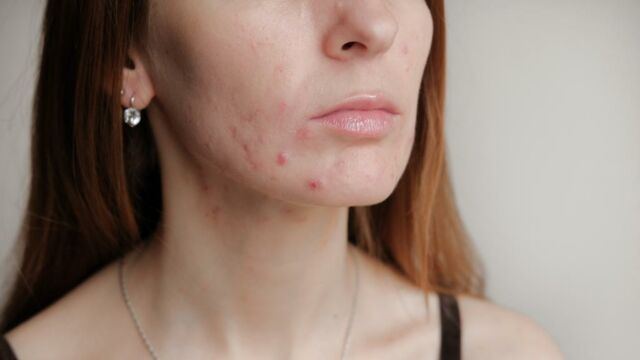When breakouts finally wind down, they can leave behind some stand-out traces of pigmentation, including red or pink spots known as post-inflammatory erythema (PIE). Despite no longer having to deal with often painful and itchy breakouts, PIE can make you just as self-conscious as acne and can be even harder to get rid of.
Discover our latest podcast
What is post-inflammatory erythema?
PIE, otherwise known as post-acne redness, is common amongst those with lighter skin tones, such as those in categories I, II and III on the Fitzpatrick skin phototype scale. These red and pink spots occur after skin trauma and often fade away on their own over weeks to months.
What causes post-inflammatory erythema?
The rosy discolouration involved in PIE is caused by the damage, dilation or inflammation of blood vessels (capillaries) involved in skin trauma. PIE is often caused by cystic acne but can also result from picking at pimples or inflammatory skin conditions such as dermatitis or sunburn.
PIE vs PIH
PIE can look very similar to post-inflammatory hyperpigmentation (PIH). However, PIH is caused by an overproduction of melanin during the skin’s healing process. Both conditions use similar treatments, but PIH is characterised by dark spots and is more likely to affect darker skin, the opposite to PIE.
A simple pressure test is needed to tell the difference between PIH and PIE. All you need to do is apply the bottom of a glass to your pigmentation. If the pigmentation disappears with pressure, then you probably have PIE.
Topical treatments for post-inflammatory erythema
PIE often fades out on its own, but it can take up to six months to do so. There are several topical products you can use to speed up the process, such as:
Hydrocortisone
Topical hydrocortisone is a steroid that can be used to reduce inflammation. However, it can be risky to use steroid creams on the face, so a doctor or dermatologist consult is required for prescription and advice.
Vitamin C
Vitamin C also has both anti-inflammatory and antioxidant properties that could help to reduce post-acne redness. There have yet to be extensive studies on the effectiveness of topical vitamin C for PIE. Still, it has previously shown to be effective at treating erythema caused by sun exposure.
Vitamin C is a popular, topical skincare ingredient and can be found over the counter (OTC) in many products, including creams and serums. For better results, vitamin C can be used in conjunction with other products such as azelaic acid and SPF.
Niacinamide
Niacinamide is one of the most popular multi-talented skincare ingredients. Like vitamin C, this vitamin B3 variant is widely available OTC and can be found in various product types.
Niacinamide is also an anti-inflammatory that can help reduce the dilation of the capillaries and eliminate redness. This ingredient also helps to regulate sebum production, which can aid in reducing acne-causing PIE.
Azelaic Acid
Azelaic acid is a relatively gentle skincare ingredient that packs some huge benefits. Azelaic acid has anti-inflammatory, anti-bacterial and keratolytic properties that help it reduce red inflammatory marks, fight off acne-causing bacteria and break down dead skin cells to promote skin regeneration.
This product is available OTC in low strengths but can also be prescribed by a dermatologist in higher concentrations.
Chemical exfoliants
Chemical exfoliants or alpha hydroxy acids (AHAs) can be effective in treating PIE. AHAs such as lactic or glycolic acid are leave-on exfoliants that help to promote healthy skin cell turnover to generate new and more evenly pigmented cells.
Green Tea
Like azelaic acid, green tea acts as an antioxidant and anti-inflammatory ingredient that can help tackle post-acne redness. This ingredient is available OTC in a number of products such as cleansers, toners, creams and serums.
SPF
Sun exposure can both cause PIE and make it harder to treat, not to mention, many topical skincare acids can be sensitising when exposed to UV rays. That’s why it’s essential to use SPF. SPF can protect against UVA and UVB rays, preventing free radical damage in the form of both burns and premature ageing.
Dermatologist treatments for post-inflammatory erythema
Sometimes our PIE can be particularly stubborn and unresponsive to topical treatments. If this is the case, then dermatologists may perform physical therapies to eliminate inflammation and redness.
Laser therapy
Dermatologists can use multiple types of laser therapy to treat PIE, but the most common is intense pulse light (IPL) and pulsed dye laser treatments. These treatments target and eliminate the inflamed blood vessels underneath the skin and often take multiple rounds to take effect.
Microneedling
Microneedling treatments such as dermabrasion may also be used to treat PIE. During this treatment, a dermatologist will use a roller covered in tiny needles to puncture the skin. These minor wounds trigger the skin to create new, collagen-rich tissue that can wipe out any redness. Similar to laser therapy, microneedling isn’t instant and may need a few applications before it takes effect.
Dermarollers can be purchased online, but we recommend only seeing a dermatologist for this kind of treatment as the wrong method can actually produce more irritation, inflammation and PIE to form.















